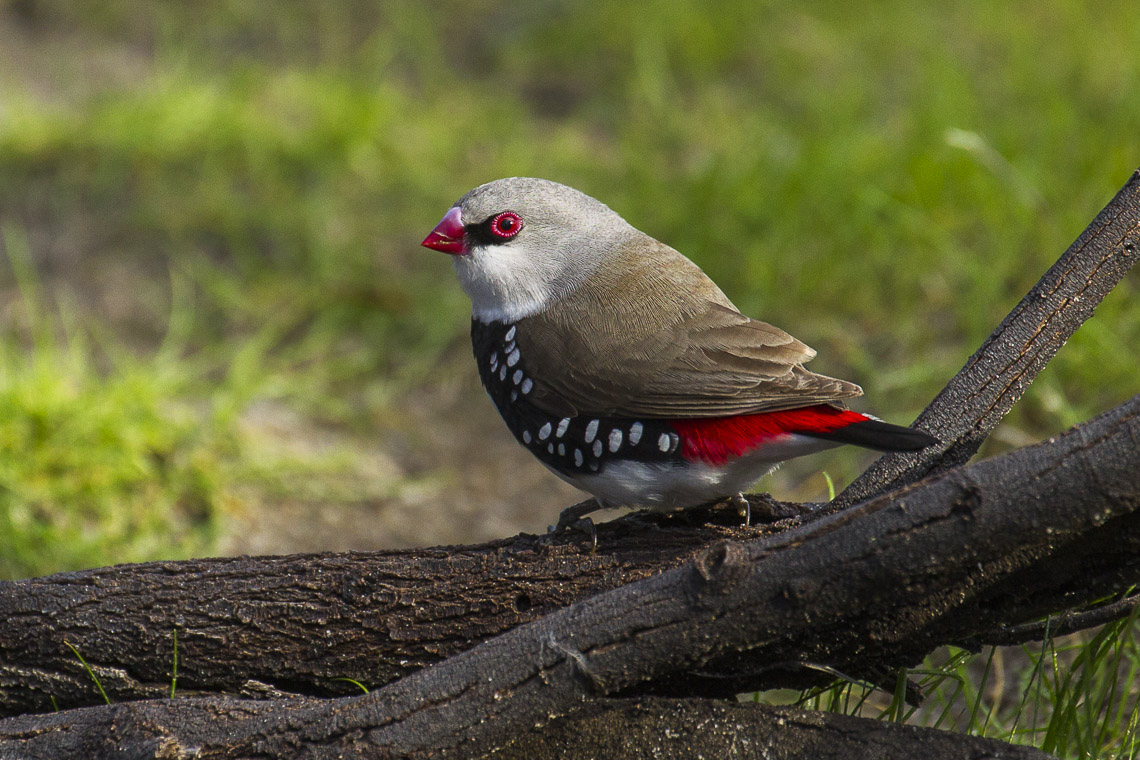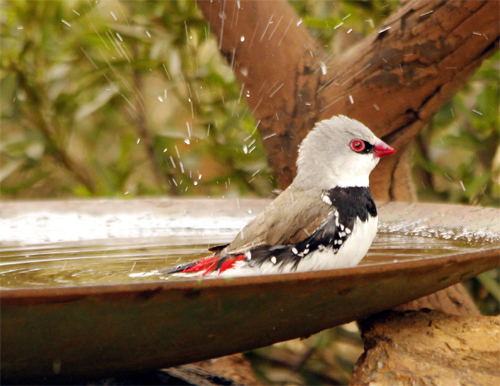I most often write about the flora and fauna of the wetter, more higher elevations of the Wombat Forest and surrounds. The forests around Daylesford, Porcupine Ridge, Glenlyon have tall messmates and candlebarks, silver wattles and blackwood, and birds such as White-eared Honeyeaters, Crescent Honeyeaters and Gang gang cockatoos. But as you head past Mount Franklin, and yours ears pop a little as you move onto the plains – a whole different world awaits. The flora and fauna of Shepherds Flat, Yandoit, and Clydesdale are remarkably different to the Daylesford area.
The trees are red box, grey box and yellow gum with black wattles, with river red gums along the watercourses. And the bird fauna is incredible: Fuscous Honeyeaters, White-plumed Honeyeaters, Brown Treecreepers and one of my very favourite birds – the Diamond Firetail.

A little stunner, photographed at Little Desert National Park by Francesco Veronesi via Wikimedia Commons.
A small bird of great beauty, the Diamond Firetail sports a neat black and grey suit with white spots, set off by a dashing crimson rump and a coral-coloured bill and eye ring.
Diamond Firetails feed on seeds of both grasses and native trees such as she-oak. One day at the Rise and Shine Bushland Reserve in Clydesdale, I chanced upon a lone Diamond Firetail foraging with a distinctive series of moves. He trundled along the ground, then leapt up to a grass seed head, grabbed it firmly in his bill, then stood on the grass head to eat the seeds. The process was repeated at the next grass tussock.
Living on seeds alone is thirsty work, and Diamond Firetails need a safe source of water in their bushland or woodland habitat. In dry times, one way to help firetails and other birds is through the provision of a bird bath or two. Bird baths are a wonderful way to enjoy your local birds, but do bear in mind they require daily maintenance to ensure the water is clean, and always topped up.
It is too hot and dry for breeding at the moment, but after the rains return and seeding grasses are available, nesting will occur anytime from August. To attract the female, the male Diamond Firetail selects a long piece of grass with a seed head, and holds it tightly in his bill. He then fluffs his spotted flank feathers and sings as he bobs up and down on the perch.
If the female approves, they will mate in the privacy of the nest. The nest is a domed affair, of grasses, seed heads and roots, and may be found in a mistletoe clump or a thick shrub such as Hedge Wattle. Very often, flowers are weaved into the entrance of the front of the nest. The inside of the nest is lined with very fine grasses and feathers weaved together.
A few years ago, I observed a Diamond Firetail nest built amongst the large sticks of the base of a Wedge-tailed Eagle nest! According to BirdLife Australia, this is a common practice, and the finches use many types of birds of prey nests such as such as a Whistling Kite, White-bellied Sea-Eagle, Wedge-tailed Eagle, Brown Falcon, Nankeen Kestrel and Square-tailed Kite. One nest of a Whistling Kite contained nine Diamond Firetail nests!

Diamond firetail in the bath. They readily use bird baths where they occur – I am jealous. I would love these birds here at Porcupine Ridge! Pic by Geoff Park, at Newstead.
Diamond Firetails forage in small flocks. In a fascinating study, bird ecologists discovered that it was actually the females in a flock that determine where a flock forages, and many females forage first for the choicest seeds. This dominant position of some females over the males and other females was indicated by the size and number of white spots along her flanks. A female with many and large spots was likely to always win over a contest over choice food items. It is very unusual in the bird world to have feather patterns playing such a big role in female – male food competition.
The spots are also distinctive enough that if you have Diamond firetails visiting your bird bath or garden, and you take photos of them, you can recognise individuals by their spot patterns.
The Diamond Firetail is less common than it once was, largely due to the removal or degradation of suitable habitat. Happily small populations are still being reported in areas such as Clydesdale, Muckleford and Fryerstown. If you have Diamond Firetails visiting your garden, or you see some out in the bush, I would love to hear from you!
Crowhurst, C. J., Zanollo, V., Griggio, M., Robertson, J. and Kleindorfer, S. (2012), White Flank Spots Signal Feeding Dominance in Female Diamond Firetails, Stagonopleura guttata. Ethology, 118: 63–75. doi: 10.1111/j.1439-0310.2011.01986.x
Diamond firetail pics by Francesco Veronesi and Geoff Park at Natural Newstead
What an amazing little bird. Great photos
Thanks Belinda! I am not a photographer so these pics are from Geoff Park and Francesco Varanesi. I must check out your pics sometime! : )
Hi Tanya, I was doing a post on Diamond Firetails on my facebook page ( https://www.facebook.com/Victorian-Natives-867592356651038/ ) when I read your article on them in the Advocate. I will now add a post with your blog details as your information is excellent as usual. Best wishes
Libby
Wow thanks Libby! I apologise for not replying for so long – I thought I had! Hope life post TFN is going well! All the best, tanya xxxx
Hi Tanya. I’m mentioning/promoting your book and blog this week in my blog titled, Writers and Their Stories. All the best. Glenice
Hi Glenice,
wow that’s lovely thank you! I look forward to reading about some other writers too : ) I will check out your blog now.
warm regards, Tanya
Gorgeous bird – and fantastic pictures. Very interesting to read about the way the feather patterns indicate dominance – I wonder how that works? Intriguing too to find out that females lead the flock. I wonder if that’s true of other birds that feed in flocks – like the red browed finch that I very occasionally see here in Sydney, and reminds me a tiny bit of this beautiful fird. Thanks for this – I’ll be looking out for more posts about your part of the world.
Hi! Great eh! I have the pdf of the article -I will upload that next week if reading science articles is your thing. I checked out your blog – love the chicken articles! I have rescue budgies and a cockatiel in an aviary, always wanted chickens but am worried I would fret over them too much – they seem to have so many different little needs and maladies. The foxes out here on the bush block, and in town actually are very bad and most of my friends have their chooks enclosed in a predator proof run 24/7. Its a shame – nice to see them doing their thing!
Ooo, I do love reading a science article. We have been lucky with foxes, since we are really not very careful with locking away our chooks at night. We’re surrounded by national park here, which is generally baited. There are still some foxes about but in our six years here we have only lost one bird that way. Now the flock of brush turkeys we also have, that I could lose!! But apparently there is an inverse relationship between foxes and brush turkeys, so I guess I’ll just have to deal with them…
Ah brush turkeys! They are such crazy little dinosaurs! Ok – so I will edit the article and add the pdf of the Diamond firetail study for your enjoyment! all the best : )